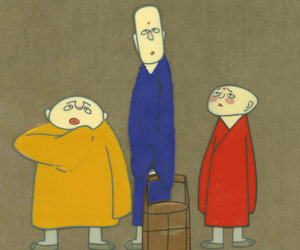Three Monks (三个和尚)(1980) (1980)
Filed under: Animation, 1980s, China, Shanghai Animation Film Studio, Technicolor,
Three Monks (三个和尚)(1980)
 Directed by:
Directed by:Xu Jingda/A Da (徐景达/阿达)
Animated by:Ma Kexuan (马克宣)
Fan Madi (范马迪)
Zhuang MinJin (庄敏瑾)
Xu Xuande (徐铉德)
Qin Baoyi (秦宝宜)
Jin Fuzai (金复载)
Backgrounds by:Chen Nianxi (陈年喜)
Studio:Shanghai Animation Film Studio (上海美术电影制片厂)
Release date:01/01/1980
Running time:18 minutes
Color process:Technicolour
Synopsis
Based on a Chinese proverb of the same name, Three Monks depicts the perpetual shift between conflict and collabouration among three Buddhist monks regarding water delivery to the temple they live in. The young monk, in red, who is the first to arrive at the temple on the hilltop, contently returned to the temple with water in a daily routine. However, upon the arrival of the second monk, in blue, the two monks formed a fragile partnership, as they both desired to reduce their workload in delivering the water. The third monk, in yellow, who consumed water rather than assisting with its delivery, caused this hypocritical friendship to collapse shortly after his arrival. No one was willing to perform the task until a huge fire in the temple compelled all the monks to collaborate to retrieve water. As they finally extinguished the fire, the three monks reestablished their friendship. They developed a mechanical infrastructure that facilitated the retrieval of water, thereby relieving them of the burden of manual labour.
Reception:
Xu Jingda, the director, was motivated to create the animated short after attending a Spring Festival Tea Party hosted by the Ministry of Culture in 1979. He heard the host discussing an ancient proverb about the three monks. Xu believed that the proverb addresses a distressing social phenomenon of indifference as a result of narcissism and selfishness shared among many individuals, which is present in both ancient and modern societies (Sun 64). In contrast to Daisy Yan Du, who considered Three Monks depicts a nostalgic longing for communist collectivism and an allegorical representation of the Shanghai Animation Film Studio’s decline since the late 1980s, Xu believed that the animation was an effective medium for conveying the philosophical message of the proverb, which emphasizes the importance of collaboration and solidarity (Du 184–185; Sun 64).
Inspired by the works of the Dutch abstractionist Piet Mondrian, Xu emphasizes an extreme sense of simplicity through the adjustment of the framing ratio and the rendering of the color palette (Sun 62). Three Monks applied a 1:1 instead of a 4:3 ratio to make everything visually square (王 80). The three monks, who are the only lively human figures featured in the animated short, dress in primary colours, that is, red, blue, and yellow, so as to easily distinguish them from one another (Ibid.).
Three Monks was awarded the Outstanding Film Award of the Ministry of Culture in 1980, Best Cartoon in the 1st Chinese Film Golden Rooster Award in 1981, Silver Medal in the 4th Odense International Fairy Tale Film Festival in Denmark in 1981, and the Silver Bear Award for Short Films at the 32nd Berlin International Film Festival in Germany in 1982 (Sun 62-63).
References:
Sun, Lijun, editor. The History of Chinese Animation. II. Routledge, 2020.
Du, Daisy Yan. “Epilogue: Television and Animated Encounters in Postsocialist China”. Animated Encounters: Transnational Movements of Chinese Animation, 1940s–1970s, edited by Allison Alexy, Honolulu: University of Hawaii Press, 2019, pp. 181-186. https://doi-org.myaccess.library.utoronto.ca/10.1515/9780824877514-008
王,静. “哪吒闹海,天书奇谈,三个和尚交给未来的一份圆满答卷.” 国家人文历史(北京),November 1, 2022. 72-81
